Preface
Acknowledgements
Introduction
Contents
Part I Black-Box Optimization
1 Nonlinear Optimization
1.1 The World of Nonlinear Optimization
1.1.1 General Formulation of the Problem
1.1.2 Performance of Numerical Methods
1.1.3 Complexity Bounds for Global Optimization
1.1.4 Identity Cards of the Fields
1.2 Local Methods in Unconstrained Minimization
1.2.1 Relaxation and Approximation
1.2.2 Classes of Differentiable Functions
1.2.3 The Gradient Method
1.2.4 Newton's Method
1.3 First-Order Methods in Nonlinear Optimization
1.3.1 The Gradient Method and Newton's Method: What Is Different?
1.3.2 Conjugate Gradients
1.3.3 Constrained Minimization
1.3.3.1 Lagrangian Relaxation
1.3.3.2 Penalty Functions
1.3.3.3 Barrier Functions
2 Smooth Convex Optimization
2.1 Minimization of Smooth Functions
2.1.1 Smooth Convex Functions
2.1.2 Lower Complexity Bounds for F∞,1L(Rn)
2.1.3 Strongly Convex Functions
2.1.4 Lower Complexity Bounds for S∞,1μ,L(Rn)
2.1.5 The Gradient Method
2.2 Optimal Methods
2.2.1 Estimating Sequences
2.2.2 Decreasing the Norm of the Gradient
2.2.3 Convex Sets
2.2.4 The Gradient Mapping
2.2.5 Minimization over Simple Sets
2.3 The Minimization Problem with Smooth Components
2.3.1 The Minimax Problem
2.3.2 Gradient Mapping
2.3.3 Minimization Methods for the Minimax Problem
2.3.4 Optimization with Functional Constraints
2.3.5 The Method for Constrained Minimization
3 Nonsmooth Convex Optimization
3.1 General Convex Functions
3.1.1 Motivation and Definitions
3.1.2 Operations with Convex Functions
3.1.3 Continuity and Differentiability
3.1.4 Separation Theorems
3.1.5 Subgradients
3.1.6 Computing Subgradients
3.1.7 Optimality Conditions
3.1.8 Minimax Theorems
3.1.9 Basic Elements of Primal-Dual Methods
3.2 Methods of Nonsmooth Minimization
3.2.1 General Lower Complexity Bounds
3.2.2 Estimating Quality of Approximate Solutions
3.2.3 The Subgradient Method
3.2.4 Minimization with Functional Constraints
3.2.5 Approximating the Optimal Lagrange Multipliers
3.2.6 Strongly Convex Functions
3.2.7 Complexity Bounds in Finite Dimension
3.2.8 Cutting Plane Schemes
3.3 Methods with Complete Data
3.3.1 Nonsmooth Models of the Objective Function
3.3.2 Kelley's Method
3.3.3 The Level Method
3.3.4 Constrained Minimization
4 Second-Order Methods
4.1 Cubic Regularization of Newton's Method
4.1.1 Cubic Regularization of Quadratic Approximation
4.1.2 General Convergence Results
4.1.3 Global Efficiency Bounds on Specific Problem Classes
4.1.3.1 Star-Convex Functions
4.1.3.2 Gradient-Dominated Functions
4.1.3.3 Nonlinear Transformations of Convex Functions
4.1.4 Implementation Issues
4.1.4.1 Minimizing the Cubic Regularization
4.1.4.2 Line Search Strategies
4.1.5 Global Complexity Bounds
4.2 Accelerated Cubic Newton
4.2.1 Real Vector Spaces
4.2.2 Uniformly Convex Functions
4.2.3 Cubic Regularization of Newton Iteration
4.2.4 An Accelerated Scheme
4.2.5 Global Non-degeneracy for Second-Order Schemes
4.2.6 Minimizing Strongly Convex Functions
4.2.7 False Acceleration
4.2.8 Decreasing the Norm of the Gradient
4.2.9 Complexity of Non-degenerate Problems
4.3 Optimal Second-Order Methods
4.3.1 Lower Complexity Bounds
4.3.2 A Conceptual Optimal Scheme
4.3.3 Complexity of the Search Procedure
4.4 The Modified Gauss–Newton Method
4.4.1 Quadratic Regularization of the Gauss–Newton Iterate
4.4.2 The Modified Gauss–Newton Process
4.4.3 Global Rate of Convergence
4.4.4 Discussion
4.4.4.1 A Comparative Analysis of Scheme (4.4.17)
4.4.4.2 Implementation Issues
Part II Structural Optimization
5 Polynomial-Time Interior-Point Methods
5.1 Self-concordant Functions
5.1.1 The Black Box Concept in Convex Optimization
5.1.2 What Does the Newton's Method Actually Do?
5.1.3 Definition of Self-concordant Functions
5.1.4 Main Inequalities
5.1.5 Self-Concordance and Fenchel Duality
5.2 Minimizing Self-concordant Functions
5.2.1 Local Convergence of Newton's Methods
5.2.2 Path-Following Scheme
5.2.3 Minimizing Strongly Convex Functions
5.3 Self-concordant Barriers
5.3.1 Motivation
5.3.2 Definition of a Self-concordant Barrier
5.3.3 Main Inequalities
5.3.4 The Path-Following Scheme
5.3.5 Finding the Analytic Center
5.3.6 Problems with Functional Constraints
5.4 Applications to Problems with Explicit Structure
5.4.1 Lower Bounds for the Parameter of a Self-concordant Barrier
5.4.2 Upper Bound: Universal Barrier and Polar Set
5.4.3 Linear and Quadratic Optimization
5.4.4 Semidefinite Optimization
5.4.5 Extremal Ellipsoids
5.4.5.1 Circumscribed Ellipsoid
5.4.5.2 Inscribed Ellipsoid with Fixed Center
5.4.5.3 Inscribed Ellipsoid with Free Center
5.4.6 Constructing Self-concordant Barriers for Convex Sets
5.4.7 Examples of Self-concordant Barriers
5.4.8 Separable Optimization
5.4.8.1 Logarithm and Exponent
5.4.8.2 Entropy Function
5.4.8.3 Increasing Power Functions
5.4.8.4 Decreasing Power Functions
5.4.8.5 Geometric Optimization
5.4.8.6 Approximation in an p-Norm
5.4.9 Choice of Minimization Scheme
6 The Primal-Dual Model of an Objective Function
6.1 Smoothing for an Explicit Model of an Objective Function
6.1.1 Smooth Approximations of Non-differentiable Functions
6.1.2 The Minimax Model of an Objective Function
6.1.3 The Fast Gradient Method for Composite Minimization
6.1.4 Application Examples
6.1.4.1 Minimax Strategies for Matrix Games
6.1.4.2 The Continuous Location Problem
6.1.4.3 Variational Inequalities with a Linear Operator
6.1.4.4 Piece-Wise Linear Optimization
6.1.5 Implementation Issues
6.1.5.1 Computational Complexity
6.1.5.2 Computational Stability
6.2 An Excessive Gap Technique for Non-smooth ConvexMinimization
6.2.1 Primal-Dual Problem Structure
6.2.2 An Excessive Gap Condition
6.2.3 Convergence Analysis
6.2.4 Minimizing Strongly Convex Functions
6.3 The Smoothing Technique in Semidefinite Optimization
6.3.1 Smooth Symmetric Functions of Eigenvalues
6.3.2 Minimizing the Maximal Eigenvalue of the Symmetric Matrix
6.4 Minimizing the Local Model of an Objective Function
6.4.1 A Linear Optimization Oracle
6.4.2 The Method of Conditional Gradients with Composite Objective
6.4.3 Conditional Gradients with Contraction
6.4.4 Computing the Primal-Dual Solution
6.4.5 Strong Convexity of the Composite Term
6.4.6 Minimizing the Second-Order Model
7 Optimization in Relative Scale
7.1 Homogeneous Models of an Objective Function
7.1.1 The Conic Unconstrained Minimization Problem
7.1.2 The Subgradient Approximation Scheme
7.1.3 Direct Use of the Problem Structure
7.1.4 Application Examples
7.1.4.1 Linear Programming
7.1.4.2 Minimization of the Spectral Radius
7.1.4.3 The Truss Topology Design Problem
7.2 Rounding of Convex Sets
7.2.1 Computing Rounding Ellipsoids
7.2.1.1 Convex Sets with Central Symmetry
7.2.1.2 General Convex Sets
7.2.1.3 Sign-Invariant Convex Sets
7.2.2 Minimizing the Maximal Absolute Value of Linear Functions
7.2.3 Bilinear Matrix Games with Non-negative Coefficients
7.2.4 Minimizing the Spectral Radius of Symmetric Matrices
7.3 Barrier Subgradient Method
7.3.1 Smoothing by a Self-Concordant Barrier
7.3.2 The Barrier Subgradient Scheme
7.3.3 Maximizing Positive Concave Functions
7.3.4 Applications
7.3.4.1 The Fractional Covering Problem
7.3.4.2 The Maximal Concurrent Flow Problem
7.3.4.3 The Minimax Problem with Nonnegative Components
7.3.4.4 Semidefinite Relaxation of the Boolean Quadratic Problem
7.3.5 Online Optimization as an Alternative to Stochastic Programming
7.3.5.1 A Decision-Making Process in an Uncertain Environment
7.3.5.2 Portfolio Management
7.3.5.3 Processes with Full Production Cycles
7.3.5.4 Discussion
7.4 Optimization with Mixed Accuracy
7.4.1 Strictly Positive Functions
7.4.2 The Quasi-Newton Method
7.4.3 Interpretation of Approximate Solutions
7.4.3.1 Relative Accuracy
7.4.3.2 Absolute Accuracy
A Solving Some Auxiliary Optimization Problems
A.1 Newton's Method for Univariate Minimization
A.2 Barrier Projection onto a Simplex
Bibliographical Comments
Chapter 1: Nonlinear Optimization
Chapter 2: Smooth Convex Optimization
Chapter 3: Nonsmooth Convex Optimization
Chapter 4: Second-Order Methods
Chapter 5: Polynomial-Time Interior-Point Methods
Chapter 6: The Primal-Dual Model of an Objective Function
Chapter 7: Optimization in Relative Scale
References
Index

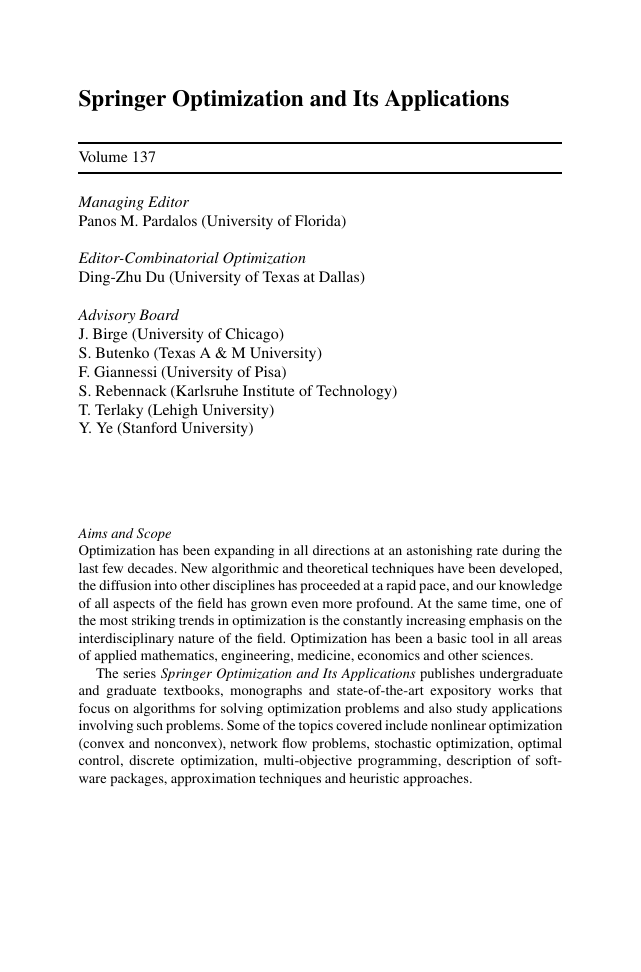

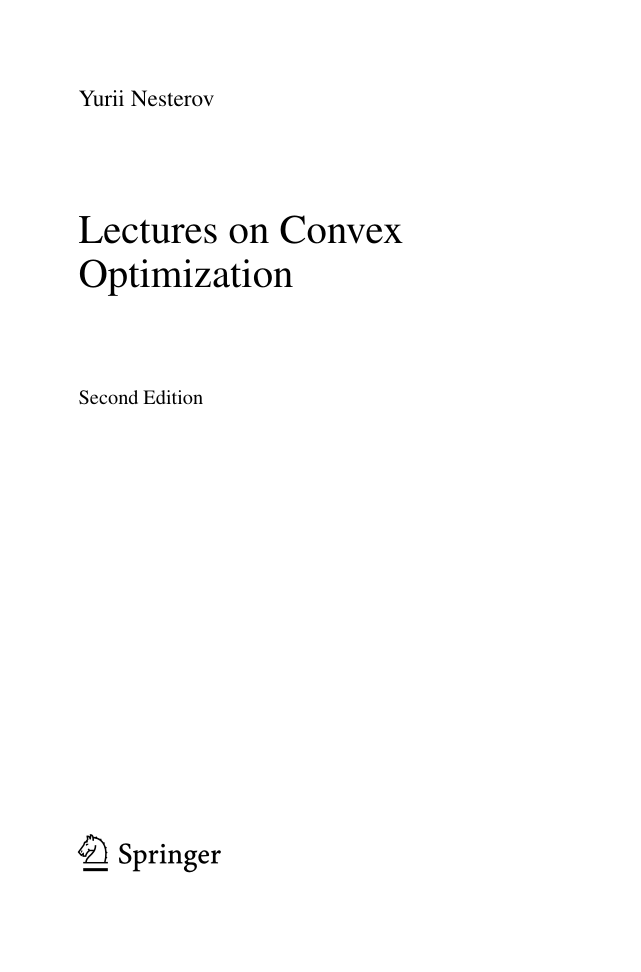
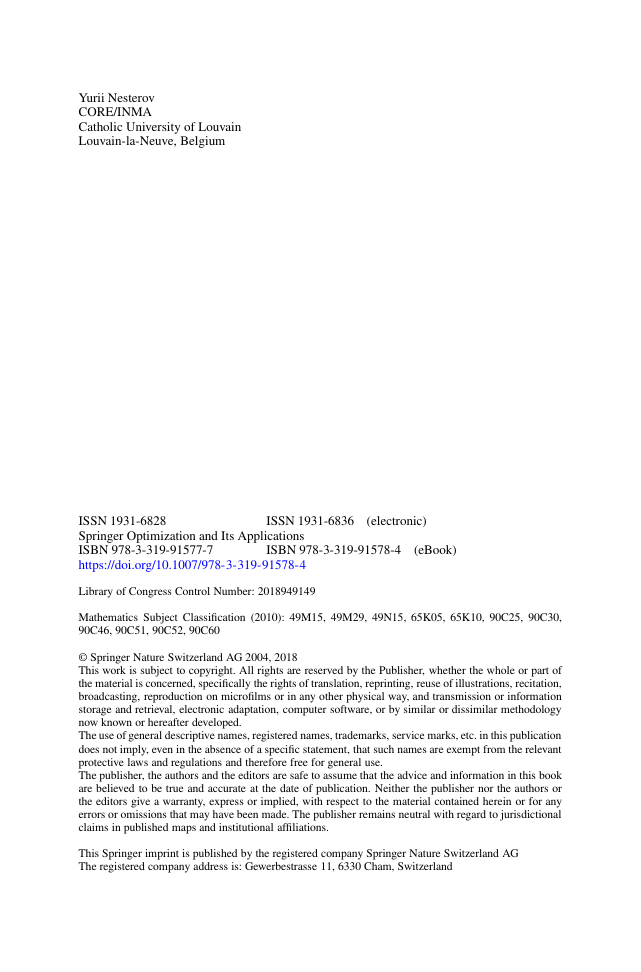

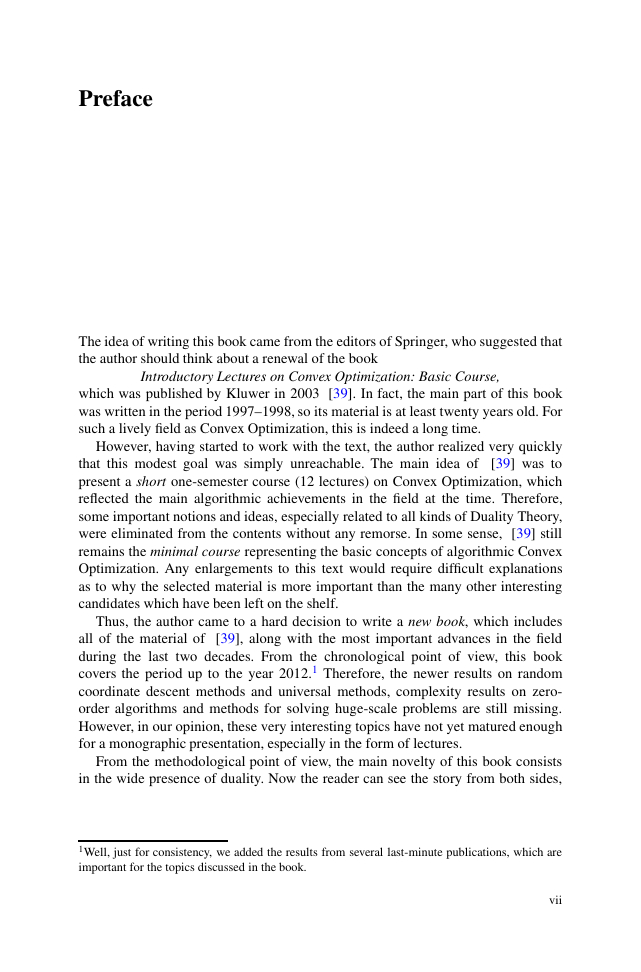
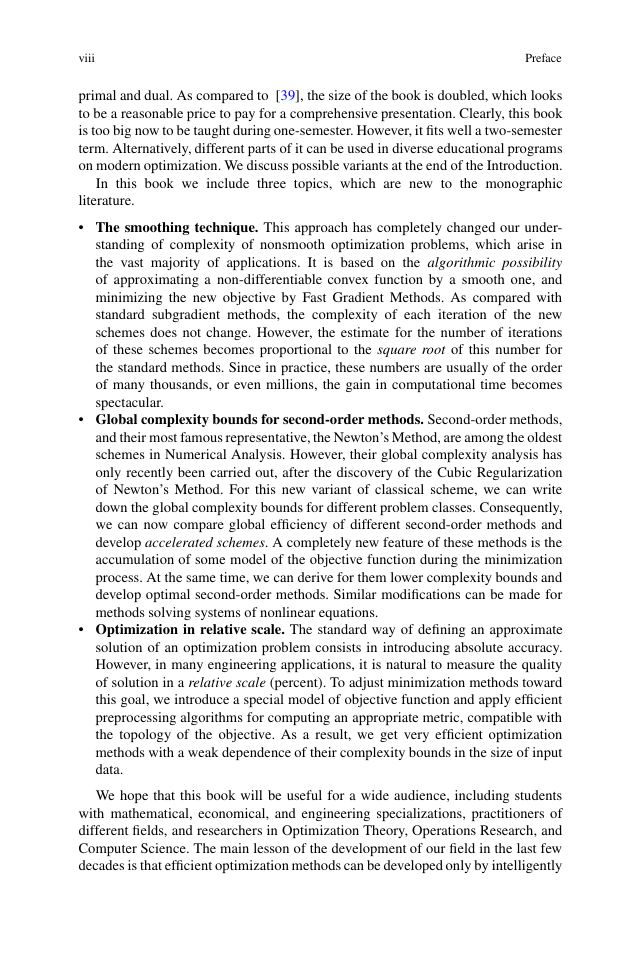








 2023年江西萍乡中考道德与法治真题及答案.doc
2023年江西萍乡中考道德与法治真题及答案.doc 2012年重庆南川中考生物真题及答案.doc
2012年重庆南川中考生物真题及答案.doc 2013年江西师范大学地理学综合及文艺理论基础考研真题.doc
2013年江西师范大学地理学综合及文艺理论基础考研真题.doc 2020年四川甘孜小升初语文真题及答案I卷.doc
2020年四川甘孜小升初语文真题及答案I卷.doc 2020年注册岩土工程师专业基础考试真题及答案.doc
2020年注册岩土工程师专业基础考试真题及答案.doc 2023-2024学年福建省厦门市九年级上学期数学月考试题及答案.doc
2023-2024学年福建省厦门市九年级上学期数学月考试题及答案.doc 2021-2022学年辽宁省沈阳市大东区九年级上学期语文期末试题及答案.doc
2021-2022学年辽宁省沈阳市大东区九年级上学期语文期末试题及答案.doc 2022-2023学年北京东城区初三第一学期物理期末试卷及答案.doc
2022-2023学年北京东城区初三第一学期物理期末试卷及答案.doc 2018上半年江西教师资格初中地理学科知识与教学能力真题及答案.doc
2018上半年江西教师资格初中地理学科知识与教学能力真题及答案.doc 2012年河北国家公务员申论考试真题及答案-省级.doc
2012年河北国家公务员申论考试真题及答案-省级.doc 2020-2021学年江苏省扬州市江都区邵樊片九年级上学期数学第一次质量检测试题及答案.doc
2020-2021学年江苏省扬州市江都区邵樊片九年级上学期数学第一次质量检测试题及答案.doc 2022下半年黑龙江教师资格证中学综合素质真题及答案.doc
2022下半年黑龙江教师资格证中学综合素质真题及答案.doc